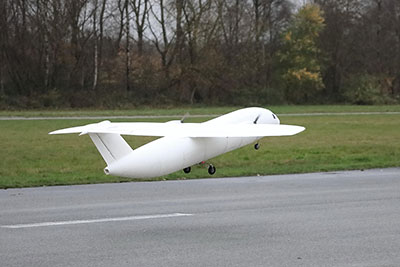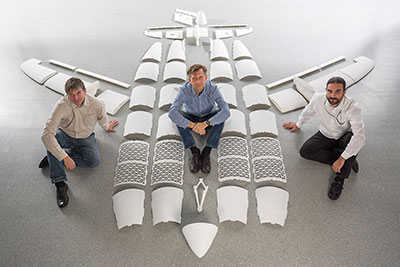A small-sized pilotless aircraft made using 3D printing (additive layer manufacturing) processes is showcasing Airbus' pioneering and innovative spirit.
Airbus is using this mini aircraft project – known as THOR (Testing High-tech Objectives in Reality) – as a testbed for futuristic aircraft technologies: from 3D-printed structural parts to advanced aerodynamics and even artificial intelligence.

"Print me an airplane"
The initial THOR version weighs approximately 21 kg. and can fit in a four-metre-by-four-metre square. It is powered by two 1.5 kW electrically-driven propellers, and 90 per cent of its structural components were 3D-printed from plastic polyamide powder.
"This mini aircraft does not represent an actual airliner design Airbus is considering, rather it is a platform to enable low-risk and fast-track development of different technologies in real flying conditions," explained Detlev Konigorski of Airbus' Emerging Technologies & Concepts activity in Germany, who oversees the THOR project. "The first version was to test whether the slogan 'Print me an airplane' can be converted into reality."
A major advantage for THOR is the short lead time of 3D-printing, which significantly reduced development time for producing the technology demonstrator compared to traditional manufacturing methods. Using an existing design concept, it took approximately seven weeks to print the THOR aircraft's 60 structural segments, followed by approximately one week for assembly and three days to fine tune the electrical systems before it was flight-ready.
Testing advanced concepts
THOR's initial flight occurred in November 2015, and the mini aircraft is resuming testing following its display at the recent Airbus Innovation Days exhibition and the ILA Berlin Air Show. "The first flight was simply about flying," said Konigorski. "Now, we want to generate basic data on things like altitude, speed and acceleration in a turn."

Follow-on THOR versions currently are being assembled at the new Center of Applied Aeronautical Research in Hamburg, Germany – known as the ZAL, in which Airbus is a major partner and shareholder. These aircraft will feature a modular design allowing for greater flexibility in airframe and structural testing.
For example, the second THOR version will accommodate interchangeable wings, including concepts for a hexagonal wing with support structure derived from a honeycomb design; a metallic aluminium wing; and a flexible wing made from carbon-fibre reinforced plastics.
Once wing testing is complete, the THOR project will focus on artificial intelligence in collaboration with the Airbus Defence and Space business unit of the Airbus Group parent company. The idea is for a THOR aircraft to land completely on its own, identifying obstacles on the runway and determining whether it is safe to touch down without support from any ground infrastructure.
The THOR mentality
Another important aspect of the THOR project is the team's "willing-to-fail approach," which helps Airbus push the envelope of experimentation. The goal is simple: implement high-risk ideas on flying vehicles as soon as possible.
"If a THOR aircraft takes off, and after 30 feet makes a nose dive back the ground, our attitude is: 'good, let's sweep it off the runway and come up with a better idea,'" Konigorski said. "In a few weeks, we can print a new aircraft!"













